Abstract
Human intestinal microbial flora were screened for their abilities to reduce nitroaromatic compounds by growing them on brain heart infusion agar plates containing 1-nitropyrene. Bacteria metabolizing 1-nitropyrene, detected by the appearance of clear zones around the colonies, were identified as Clostridium leptum, Clostridium paraputrificum, Clostridium clostridiiforme, another Clostridium sp., and a Eubacterium sp. These bacteria produced aromatic amines from nitroaromatic compounds, as shown by thin-layer chromatography, high-pressure liquid chromatography, and biochemical tests. Incubation of three of these bacteria with 1-nitropyrene, 1,3-dinitropyrene, and 1,6-dinitropyrene inactivated the direct-acting mutagenicity associated with these compounds. Menadione and o-iodosobenzoic acid inhibited nitroreductase activity in all of the isolates, indicating the involvement of sulfhydryl groups in the active site of the enzyme. The optimum pH for nitroreductase activity was 8.0. Only the Clostridium sp. required added flavin adenine dinucleotide for nitroreductase activity. The nitroreductases were constitutive and extracellular. An activity stain for the detection of nitroreductase on anaerobic native polyacrylamide gels was developed. This activity stain revealed only one isozyme in each bacterium but showed that the nitroreductases from different bacteria had distinct electrophoretic mobilities.
Full text
PDF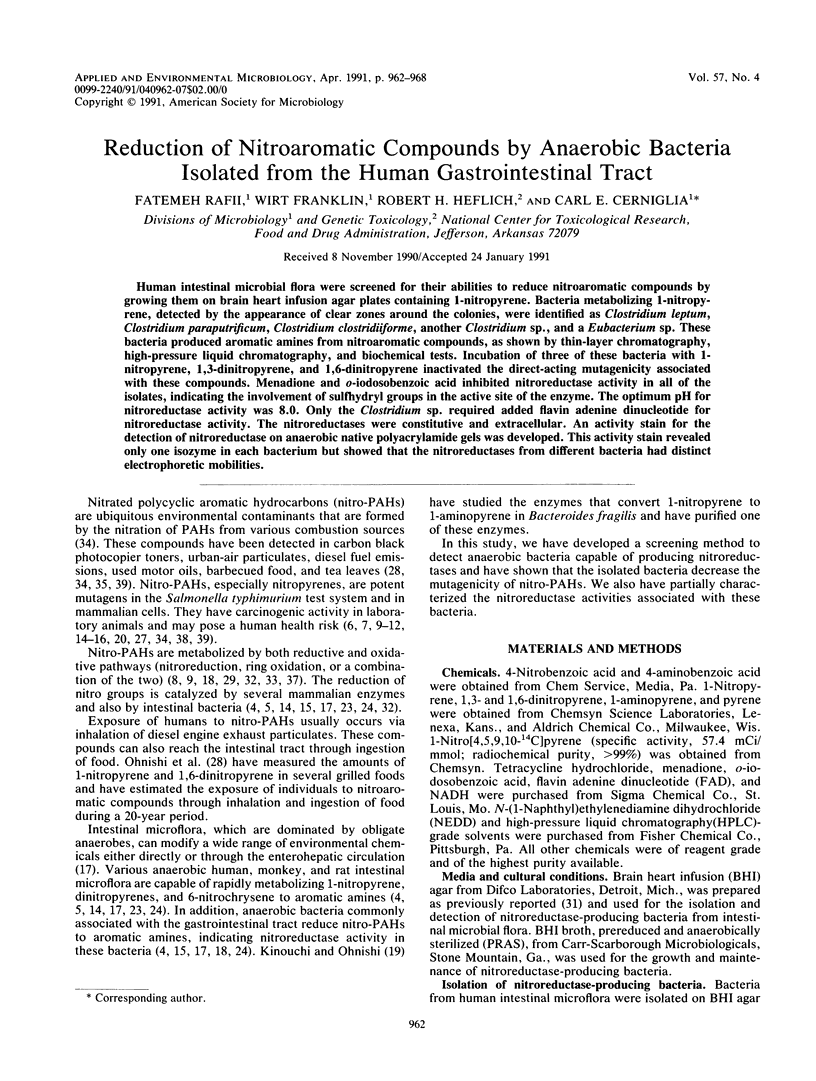
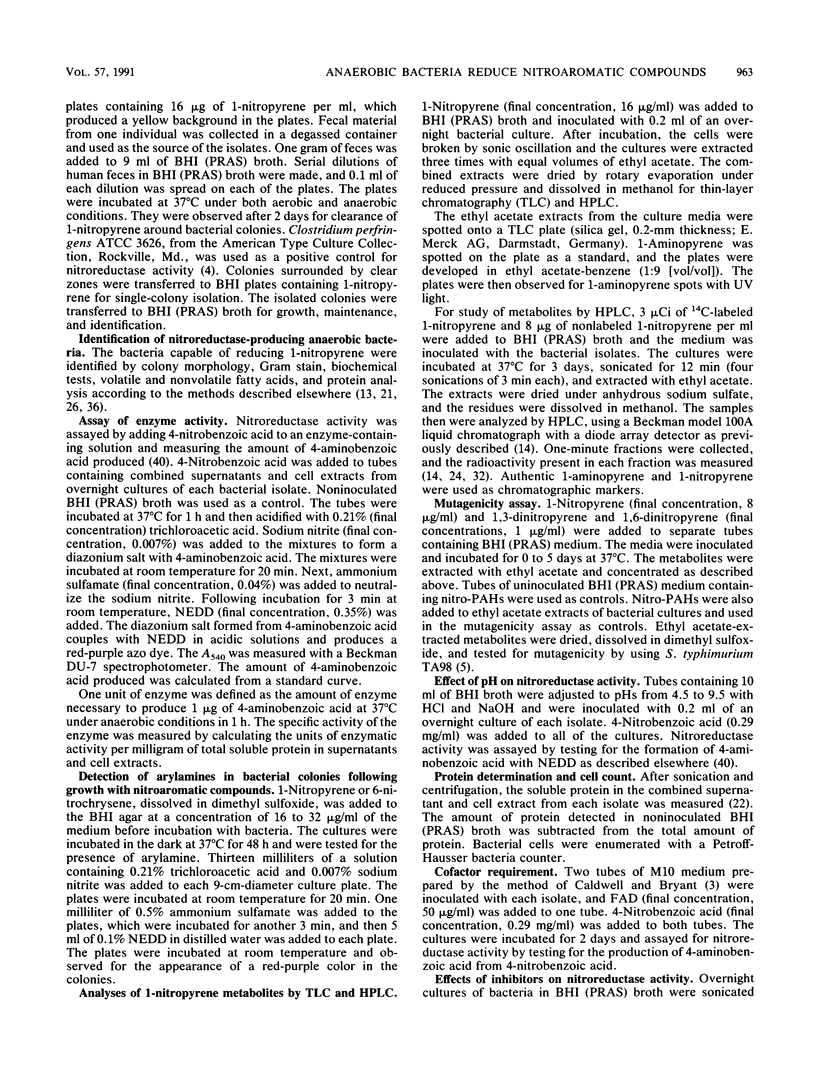


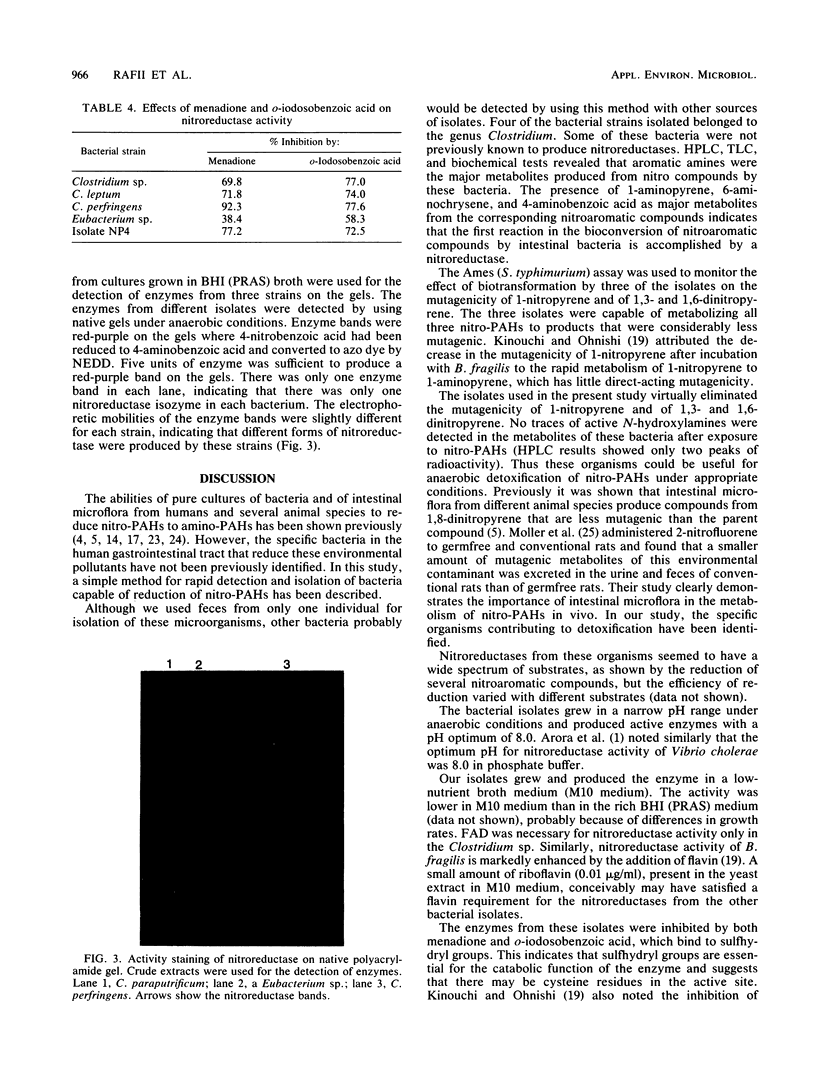
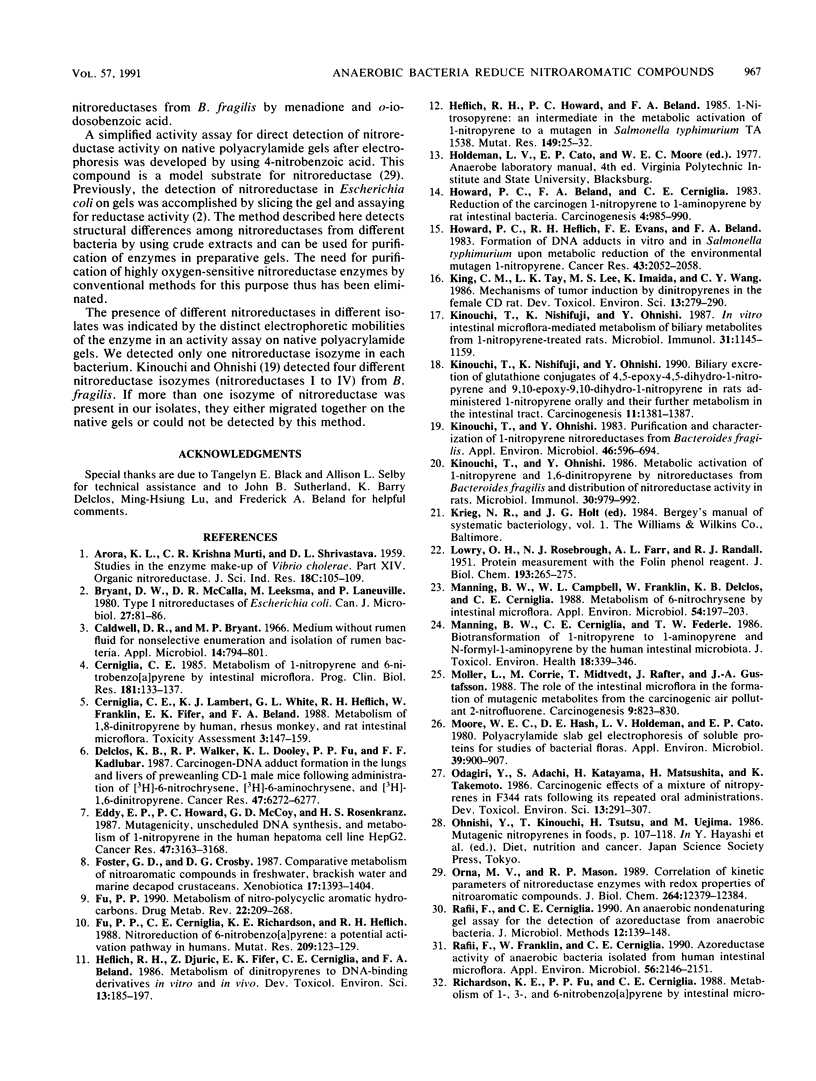
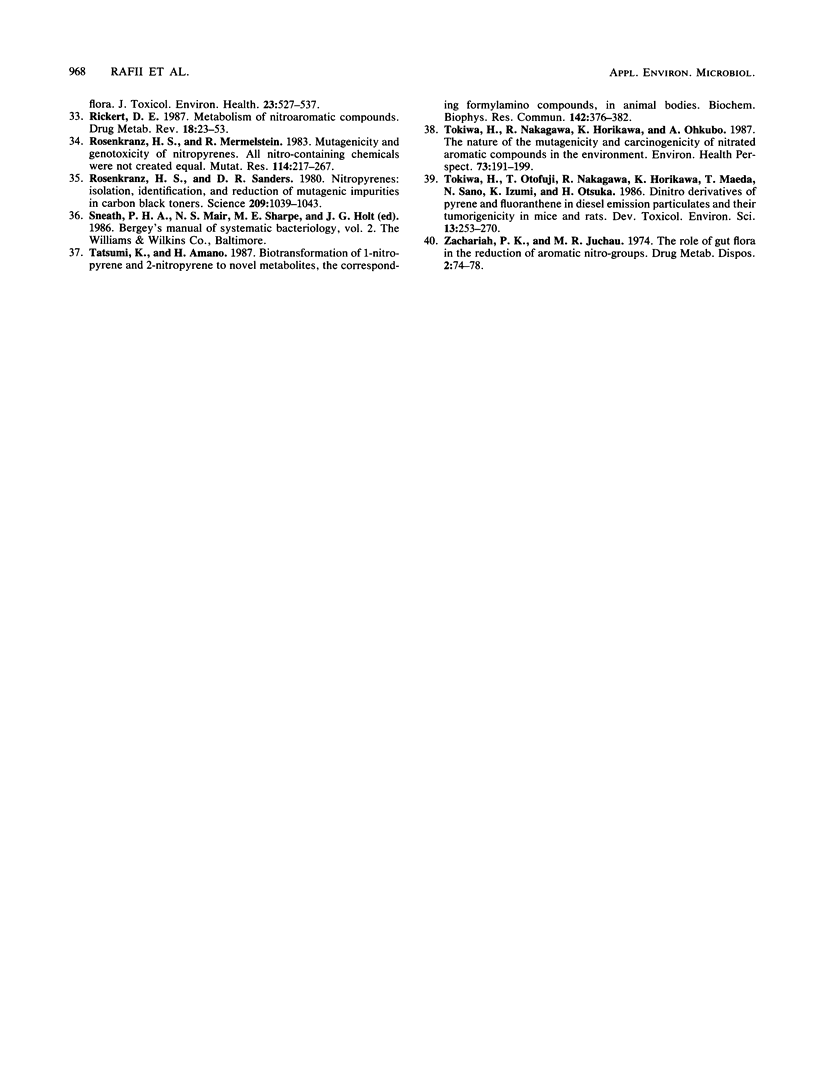
Images in this article
Selected References
These references are in PubMed. This may not be the complete list of references from this article.
- Bryant D. W., McCalla D. R., Leeksma M., Laneuville P. Type I nitroreductases of Escherichia coli. Can J Microbiol. 1981 Jan;27(1):81–86. doi: 10.1139/m81-013. [DOI] [PubMed] [Google Scholar]
- Caldwell D. R., Bryant M. P. Medium without rumen fluid for nonselective enumeration and isolation of rumen bacteria. Appl Microbiol. 1966 Sep;14(5):794–801. doi: 10.1128/am.14.5.794-801.1966. [DOI] [PMC free article] [PubMed] [Google Scholar]
- Cerniglia C. E. Metabolism of 1-nitropyrene and 6-nitrobenzo(a)pyrene by intestinal microflora. Prog Clin Biol Res. 1985;181:133–137. [PubMed] [Google Scholar]
- Delclos K. B., Walker R. P., Dooley K. L., Fu P. P., Kadlubar F. F. Carcinogen-DNA adduct formation in the lungs and livers of preweanling CD-1 male mice following administration of [3H]-6-nitrochrysene, [3H]-6-aminochrysene, and [3H]-1,6-dinitropyrene. Cancer Res. 1987 Dec 1;47(23):6272–6277. [PubMed] [Google Scholar]
- Eddy E. P., Howard P. C., McCoy G. D., Rosenkranz H. S. Mutagenicity, unscheduled DNA synthesis, and metabolism of 1-nitropyrene in the human hepatoma cell line HepG2. Cancer Res. 1987 Jun 15;47(12):3163–3168. [PubMed] [Google Scholar]
- Foster G. D., Crosby D. G. Comparative metabolism of nitroaromatic compounds in freshwater, brackish water and marine decapod crustaceans. Xenobiotica. 1987 Dec;17(12):1393–1404. doi: 10.3109/00498258709044000. [DOI] [PubMed] [Google Scholar]
- Fu P. P., Cerniglia C. E., Richardson K. E., Heflich R. H. Nitroreduction of 6-nitrobenzo[a]pyrene: a potential activation pathway in humans. Mutat Res. 1988 Nov-Dec;209(3-4):123–129. doi: 10.1016/0165-7992(88)90028-0. [DOI] [PubMed] [Google Scholar]
- Fu P. P. Metabolism of nitro-polycyclic aromatic hydrocarbons. Drug Metab Rev. 1990;22(2-3):209–268. doi: 10.3109/03602539009041085. [DOI] [PubMed] [Google Scholar]
- Heflich R. H., Djuric Z., Fifer E. K., Cerniglia C. E., Beland F. A. Metabolism of dinitropyrenes to DNA-binding derivatives in vitro and in vivo. Dev Toxicol Environ Sci. 1986;13:185–197. [PubMed] [Google Scholar]
- Heflich R. H., Howard P. C., Beland F. A. 1-Nitrosopyrene: an intermediate in the metabolic activation of 1-nitropyrene to a mutagen in Salmonella typhimurium TA1538. Mutat Res. 1985 Mar;149(1):25–32. doi: 10.1016/0027-5107(85)90005-3. [DOI] [PubMed] [Google Scholar]
- Howard P. C., Beland F. A., Cerniglia C. E. Reduction of the carcinogen 1-nitropyrene to 1-aminopyrene by rat intestinal bacteria. Carcinogenesis. 1983 Aug;4(8):985–990. doi: 10.1093/carcin/4.8.985. [DOI] [PubMed] [Google Scholar]
- Howard P. C., Heflich R. H., Evans F. E., Beland F. A. Formation of DNA adducts in vitro and in Salmonella typhimurium upon metabolic reduction of the environmental mutagen 1-nitropyrene. Cancer Res. 1983 May;43(5):2052–2058. [PubMed] [Google Scholar]
- King C. M., Tay L. K., Lee M. S., Imaida K., Wang C. Y. Mechanisms of tumor induction by dinitropyrenes in the female CD rat. Dev Toxicol Environ Sci. 1986;13:279–290. [PubMed] [Google Scholar]
- Kinouchi T., Nishifuji K., Ohnishi Y. Biliary excretion of glutathione conjugates of 4,5-epoxy-4,5-dihydro-1- nitropyrene and 9,10-epoxy-9,10-dihydro-1-nitropyrene in rats administered 1-nitropyrene orally and their further metabolism in the intestinal tract. Carcinogenesis. 1990 Aug;11(8):1381–1387. doi: 10.1093/carcin/11.8.1381. [DOI] [PubMed] [Google Scholar]
- Kinouchi T., Nishifuji K., Ohnishi Y. In vitro intestinal microflora-mediated metabolism of biliary metabolites from 1-nitropyrene-treated rats. Microbiol Immunol. 1987;31(12):1145–1159. doi: 10.1111/j.1348-0421.1987.tb01349.x. [DOI] [PubMed] [Google Scholar]
- Kinouchi T., Ohnishi Y. Metabolic activation of 1-nitropyrene and 1,6-dinitropyrene by nitroreductases from Bacteroides fragilis and distribution of nitroreductase activity in rats. Microbiol Immunol. 1986;30(10):979–992. doi: 10.1111/j.1348-0421.1986.tb03028.x. [DOI] [PubMed] [Google Scholar]
- Kinouchi T., Ohnishi Y. Purification and characterization of 1-nitropyrene nitroreductases from Bacteroides fragilis. Appl Environ Microbiol. 1983 Sep;46(3):596–604. doi: 10.1128/aem.46.3.596-604.1983. [DOI] [PMC free article] [PubMed] [Google Scholar]
- LOWRY O. H., ROSEBROUGH N. J., FARR A. L., RANDALL R. J. Protein measurement with the Folin phenol reagent. J Biol Chem. 1951 Nov;193(1):265–275. [PubMed] [Google Scholar]
- Manning B. W., Campbell W. L., Franklin W., Delclos K. B., Cerniglia C. E. Metabolism of 6-nitrochrysene by intestinal microflora. Appl Environ Microbiol. 1988 Jan;54(1):197–203. doi: 10.1128/aem.54.1.197-203.1988. [DOI] [PMC free article] [PubMed] [Google Scholar]
- Manning B. W., Cerniglia C. E., Federle T. W. Biotransformation of 1-nitropyrene to 1-aminopyrene and N-formyl-1-aminopyrene by the human intestinal microbiota. J Toxicol Environ Health. 1986;18(3):339–346. doi: 10.1080/15287398609530875. [DOI] [PubMed] [Google Scholar]
- Moore W. E., Hash D. E., Holdeman L. V., Cato E. P. Polyacrylamide slab gel electrophoresis of soluble proteins for studies of bacterial floras. Appl Environ Microbiol. 1980 Apr;39(4):900–907. doi: 10.1128/aem.39.4.900-907.1980. [DOI] [PMC free article] [PubMed] [Google Scholar]
- Möller L., Corrie M., Midtvedt T., Rafter J., Gustafsson J. A. The role of the intestinal microflora in the formation of mutagenic metabolites from the carcinogenic air pollutant 2-nitrofluorene. Carcinogenesis. 1988 May;9(5):823–830. doi: 10.1093/carcin/9.5.823. [DOI] [PubMed] [Google Scholar]
- Odagiri Y., Adachi S., Katayama H., Matsushita H., Takemoto K. Carcinogenic effects of a mixture of nitropyrenes in F344 rats following its repeated oral administrations. Dev Toxicol Environ Sci. 1986;13:291–307. [PubMed] [Google Scholar]
- Orna M. V., Mason R. P. Correlation of kinetic parameters of nitroreductase enzymes with redox properties of nitroaromatic compounds. J Biol Chem. 1989 Jul 25;264(21):12379–12384. [PubMed] [Google Scholar]
- Rafii F., Franklin W., Cerniglia C. E. Azoreductase activity of anaerobic bacteria isolated from human intestinal microflora. Appl Environ Microbiol. 1990 Jul;56(7):2146–2151. doi: 10.1128/aem.56.7.2146-2151.1990. [DOI] [PMC free article] [PubMed] [Google Scholar]
- Rickert D. E. Metabolism of nitroaromatic compounds. Drug Metab Rev. 1987;18(1):23–53. doi: 10.3109/03602538708998299. [DOI] [PubMed] [Google Scholar]
- Rosenkranz H. S., McCoy E. C., Sanders D. R., Butler M., Kiriazides D. K., Mermelstein R. Nitropyrenes: isolation, identificaton, and reduction of mutagenic impurities in carbon black and toners. Science. 1980 Aug 29;209(4460):1039–1043. doi: 10.1126/science.6996095. [DOI] [PubMed] [Google Scholar]
- Rosenkranz H. S., Mermelstein R. Mutagenicity and genotoxicity of nitroarenes. All nitro-containing chemicals were not created equal. Mutat Res. 1983 Apr;114(3):217–267. doi: 10.1016/0165-1110(83)90034-9. [DOI] [PubMed] [Google Scholar]
- Tatsumi K., Amano H. Biotransformation of 1-nitropyrene and 2-nitrofluorene to novel metabolites, the corresponding formylamino compounds, in animal bodies. Biochem Biophys Res Commun. 1987 Jan 30;142(2):376–382. doi: 10.1016/0006-291x(87)90284-1. [DOI] [PubMed] [Google Scholar]
- Tokiwa H., Nakagawa R., Horikawa K., Ohkubo A. The nature of the mutagenicity and carcinogenicity of nitrated, aromatic compounds in the environment. Environ Health Perspect. 1987 Aug;73:191–199. doi: 10.1289/ehp.8773191. [DOI] [PMC free article] [PubMed] [Google Scholar]
- Tokiwa H., Otofuji T., Nakagawa R., Horikawa K., Maeda T., Sano N., Izumi K., Otsuka H. Dinitro derivatives of pyrene and fluoranthene in diesel emission particulates and their tumorigenicity in mice and rats. Dev Toxicol Environ Sci. 1986;13:253–270. [PubMed] [Google Scholar]
- Zachariah P. K., Juchau M. R. The role of gut flora in the reduction of aromatic nitro-groups. Drug Metab Dispos. 1974 Jan-Feb;2(1):74–78. [PubMed] [Google Scholar]




